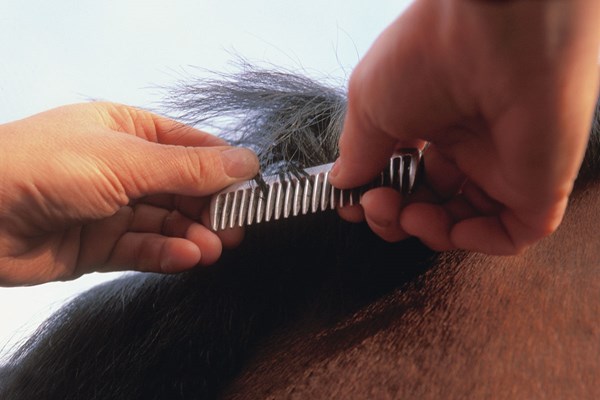 Credit: © ARND BRONKHORST To thin and shorten a mane, grasp the end of a small section of hair in one hand, backcomb the mane toward the neck using a mane comb, wrap the remaining hairs around the comb a few times and pull downward to remove them by the roots.
Credit: © ARND BRONKHORST To thin and shorten a mane, grasp the end of a small section of hair in one hand, backcomb the mane toward the neck using a mane comb, wrap the remaining hairs around the comb a few times and pull downward to remove them by the roots.Q: I am getting ready for my first show, and my barn friends tell me I need to pull my horse’s mane so it can be braided. I’ve never done this before, and it sounds painful. How do I do this properly so I avoid hurting my horse?
LIV GUDE
A: Mane-pulling is the act of removing individual hairs of the mane from the root with the purpose of thinning and shortening it. This is done for the horse’s professional presentation and to maintain a manageable thickness and length for showing and braiding. Generally speaking, pulling the mane is only required for horses who are shown in disciplines for which you would braid.
The key to a short, thin and tidy mane is practice. Though most horses don’t mind having their manes pulled and some even enjoy it, there are a few super-sensitive ones who require extra care. Before you start, make sure your horse is used to having his mane handled. Every time you ride or spend time with him, tug on or even simply brush his mane. Don’t try to pull your horse’s mane for the first time the night before a big show. Give yourself plenty of time, and don’t forget to reward your horse for tolerating this new grooming technique.
The best time to pull your horse’s mane is during the spring while he is shedding out his winter coat. This is because the hair is already loose, and it is the natural time of year for it to come out. Do it on a warm day after you have ridden or longed your horse while his pores are open. The exercise and warm air will make the process a bit easier for you and, therefore, more comfortable for him if he’s sensitive.
Start by gathering your supplies: a pulling comb (usually a small metal comb about 3–4 inches long), a standard mane-and-tail brush and, if you’d like, a pair of latex gloves to make gripping the hair easier.
When you are pulling a mane to prepare it for braiding, gauge the proper length using the width of your hand plus about an inch. Then put in a few test braids, exactly as you would for a show. Manes vary in texture and thickness, so your test braids will tell you if you need to trim more, thin more or adjust the braids. For dressage braids, I leave the mane about a hand width plus a smidge.
You can begin at either end of the mane—at the withers or the poll. Stand on a stool if your horse is tall. Take an inch-wide section of hair in your left hand and hold it toward the ends. With the pulling comb in your right hand, rat (or tease) the hair toward your horse’s neck, leaving the longer strands in the fingers of your left hand. Take those remaining hairs, wrap them around the comb a couple times and pull straight down to remove them at the roots. Some horses prefer you to pull straight up and some in between. Play around to find what works best for you and your horse.
I find that working up or down the neck and then back again is easier on horses than spending a lot of time in one area. Once you have finished one pass of the mane, brush it out with your mane-and-tail brush and start over. Expect to go back and forth several times. I prefer to spread the process over several days to see how the mane looks at its new length and decide whether it’s OK or needs to be shorter or thinner. After you have finished, take scissors or a detached clipper blade and trim the ends of the uneven hairs that are left to give the mane a polished but natural look.
If your horse’s mane is already thin and you just need to shorten it, use a clipper blade (again, not attached to the clippers) or the blade of an open scissor to go slowly up and down the mane, razoring just a few hairs at a time close to the ends to create a shorter but natural look.
If your horse has a particularly thick mane, keep your fingers and him happy by pulling only a little at a time. Once it has been thinned out, tending to it weekly will ensure you’ll never have to worry about pulling that extra-thick mane again.
If your horse is extra-sensitive, it is essential that you pull his mane on a dry, warm day right after he has been exercised. You can get a topical lidocaine gel or spray from your vet and administer it right at the base of the mane to reduce any pain or irritation that your horse may feel. If this still doesn’t work, it may be necessary to have your veterinarian administer sedation so you can do it while your horse is feeling sleepy.
If your horse fidgets, bites, rears or behaves undesirably, go back to basics. Can he stand patiently in the cross-ties for a long period of time? Does he respect your personal space when leading and handling him? Remember to use positive reinforcement, and don’t be afraid to seek professional help if your horse just won’t tolerate having his mane pulled. It’s essential to work on ground manners and safety before you tackle mane-pulling.
Mane-pulling does not need to be painful or traumatic. Just take your time, practice and get help if you need it.
A former groom for several Olympians, Liv Gude is the visionary behind the Professional Equine Grooms website (www.proequinegrooms. com), which brings professional grooms of all disciplines together in a supportive community where information is readily shared. The website provides everything from grooming tips to job listings and blogs. It hosts weekly contests for the best tips, tricks and tools submitted by website guests. Liv now works full-time on her website and enjoys her Grand Prix dressage horse, Miguel, and hunter, Comet. Both horses earn their keep by posing as models for the website.
This article originally appeared in the June 2013 issue of Practical Horseman.





